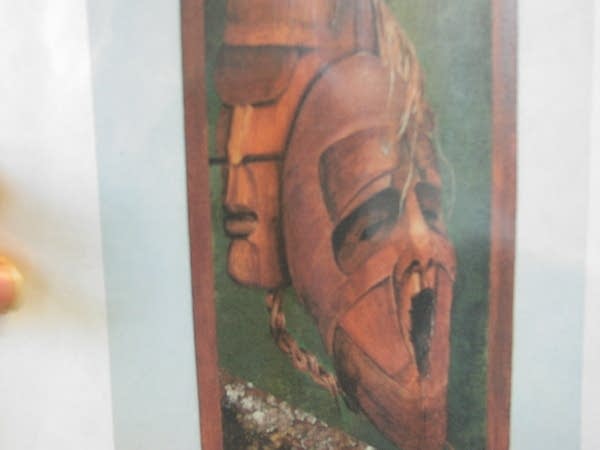Selling prison art
Go Deeper.
Create an account or log in to save stories.
Like this?
Thanks for liking this story! We have added it to a list of your favorite stories.

Matthew Walker's artwork is very raw. In an interview room in Stillwater prison, he describes one of his pieces.

"It's a self-portrait, but it's a scarred self-portrait. There's blood coming from the nose, from the eyes, the mouth, and the head," says Walker. "People can walk around feeling depressed and you never know. I've had stuff going on that I never felt I could deal with. This was my way to express it."
Walker never drew before he went to prison for a sex offense. Then he joined Minnesota's offender art program at Stillwater.
His self-portrait, along with three of his other pieces, is for sale through an online gallery called Artistic Spirit in Indianapolis. An art teacher at the prison sent gallery owner Julie Klaper some photos of inmate artwork after she expressed interest in buying some. She bought more than two dozen pieces by five inmates over a year ago.
Turn Up Your Support
MPR News helps you turn down the noise and build shared understanding. Turn up your support for this public resource and keep trusted journalism accessible to all.
"There was a certain integrity of the work about the artist either working in a format or in a methodology that was different," says Klaper. "It's work that evokes a strong emotion on the part of the viewer, and it might not make you feel good, but it's certainly thought-provoking about the circumstances of the artist and why he created that particular piece."

Klaper sells what's called outsider art, created by untrained artists. The term was coined in 1972 to describe work that is raw and unshaped by mainstream culture. Klaper is taking the pictures to an exhibition called Outsiders Outside in Michigan this Labor Day weekend.
She's looking for buyers like David Mattingly from Indianapolis. He bought four prison art pieces from Julie Klaper's online gallery.
Mattingly didn't read the artist label when he bought his first two pieces. After Klaper told him the pieces were inmate art, he bought two more by the same artist, who's also in the Stillwater prison. It's a series of water color portraits.
"They are sort of works created from what we might call the inner self," says Mattingly. "Several of them have long slender necks, they're very small in size, very exquisitely rendered on this paper."
Mattingly only knew the inmate artist's last name when he bought the portraits. That's the only piece of information Julie Klaper knew herself.

Both Klaper and Mattingly say they're more interested in the art than the artists. When told the inmate is serving time for murder, Mattingly says he doesn't moralize about prison art. But he admits if he had known prior to his purchase what the inmate had done, it might have affected his decision to buy the pictures.
"I certainly won't put them up for sale just because I now know what the inmate has done," says Mattingly. "I will take them for what they are and just go with it. I certainly won't buy any more, but they are what they are."
The Minnesota Department of Corrections has an offender locator Web page that provides an inmate's full name, entry and release dates, and a short offense description.
Erik Skon, assistant commissioner at the state Corrections Department, says although a lot of the offender information is public, when it comes to selling prison art, the department only provides the inmate's last name because it wants to keep the sale as a fiscal relationship.

"We really don't feel a responsibility to provide more information," says Skon. "I think art is art, and if you find something appealing to your eye, and you happen to know it came from an offender and was painted inside of a prison, and that creates a little more interest for you, I think that's enough information."
Skon says prison art sales are very uncommon. Recently, 23 inmates at Stillwater, including Matthew Walker, had the opportunity to display work at an art exhibition in Lake Elmo. Of the 150 displayed, only about a dozen pieces sold.
Skon says the Corrections Department doesn't encourage inmates to sell their art. The department's policy limits sales to one bulk purchase a year if a gallery or collector is interested. Inmates receive about 75 percent of the money, and the remainder goes to restorative justice programs.
Matthew Walker says on average, he sells his pieces for anywhere from $30 to $50. He uses some of the money for food, and the rest for art supplies and books.
But the art program is about more than inmates making a few extra bucks. Skon says they're trying to prepare inmates for re-entry into society.

"We think art fulfills a role in terms of that it challenges offenders to be creative, it challenges them intellectually, and it provides them a healthy outlet, in which they can quietly do their time, and that's the goal," says Skon.
According to Skon, by keeping inmates busy, it reduces assaults and facility damages.
Inmate and artist Matthew Walker says art is the easiest way to get inmates to make positive changes.
"I would think that'd be the most ideal thing, to have a person start looking at themselves and start changing -- even if it's just initially on canvas or paper -- so that later on those changes can be more permanent within themselves," says Walker.
Fewer than 200 out of 9,000 inmates participate in offender art programs in Minnesota prisons. When asked whether it's wrong for inmates to earn money while in prison, Skon says prisoners are already being punished by being separated from society. Beyond that, he says it's just a debate about privileges.





